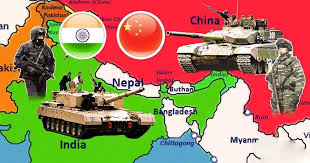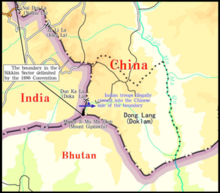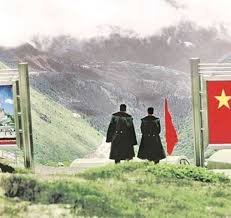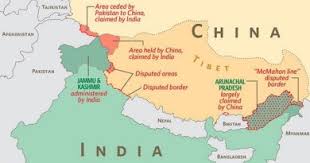China-India Standoff; Tactical Face of Strategic Contest
- Saleem Qamar Butt
- Jun 29, 2020
- 8 min read
The supreme art of war is to subdue the enemy without fighting.~Sun Tzu
The entire Sino-Indian border (including the western LAC, the small undisputed section in the centre, and the McMahon Line in the East) is 4,056 km long and traverses disputed territory of Ladakh, and four Indian states: Uttarakhand, Himachal Pradesh, Sikkim, and disputed Arunachal Pradesh. Beijing has never recognized the 1914 boundary, known as the McMahon Line, and currently claims 90,000 square kilometers— nearly all of what constitutes India's Arunachal Pradesh state, which was clearly stated to the visiting Indian Prime Minister Nehru in 1959 by Chinese Prime Minister Zhou Enlai. Subsequently, the border dispute led to the 1962 Indo-China War, in which India was humiliated and lost a lot of territory; Beijing retained Aksai Chin, a strategic corridor linking Tibet to China. India still claims the entire Aksai Chin region as its own, as well as the nearby China-controlled Shaksgam valley in northern Kashmir. Brief and small-scale skirmishes took place in 1967 at Nathu La, India's highest mountain pass in northeastern Sikkim state and in 1975 at Tulung La Arunachal Pradesh. In 2017, India and China had a months-long high-altitude standoff in Bhutan's Doklam region; however, the issue was resolved after talks. The Doklam plateau is strategically significant as it gives China access to the so-called “chicken's neck” or Siliguri Corridor, which is a narrow stretch of land of about 22 kilometers connecting India's northeastern Seven sister states with mainland (i.e. Assam, Manipur, Meghalaya, Mizoram, Nagaland, Sikkim and Tripura). These seven states have always remained simmering with independence movements like Indian Occupied Kashmir and have mostly been ruled by local nationalist political parties.
On 5th May 2020, a scuffle broke out between Indian and Chinese troops at the Pangong Tso Lake, located 14,000 feet (4,270 meters) above the sea level in the Himalayan region of Ladakh. A video shared on social media showed soldiers from both nations engaged in fistfights and stone-pelting at the Line of Actual Control / contact (LAC). Three days later and nearly 1,200km (745 miles) away to the east along the LAC, another fight erupted at Nathu La Pass in the Indian claimed state of Sikkim. Since then, the India-China border has seen soldiers from both sides camping along several disputed areas, with each side accusing the other of trespassing. At least 10,000 PLA soldiers are now believed to be camping on what India claims to be its territory - Pangong Tso Lake, Galwan Valley and Demchok in Ladakh, and Nathu La in Sikkim. Reportedly, at least 20 plus Indian soldiers including a commanding officer and a few officers were killed just by stones, clubs and fist fighting and a dozen plus taken prisoner later released by Chinese in this most recent clash, causing media frenzy, public outcry and political uproar against hyper self inflated and extremist far right nationalist Modi Government in India. So far Modi and his jingoist RSS /BJP fanatics are shell shocked and thoroughly embarrassed as their saffron brand Nazi Hindutva had been given a bloody nose by Chinese without firing a single shot. The cigarette legged baton carrying RSS terrorists who were having a free day to kill innocent Muslims all over India seem to have disappeared in their rat holes. To take stock of the situation, on May 22, India's army chief General Manoj Mukund dashed off to Leh, the capital of Ladakh territory which was carved out of Indian-administered Kashmir in August 2019 after declaring Ladakh as a union territory and Jammu and Kashmir as an integral part of India by abrogating article 370 and 35 A of Indian constitution that is considered one of the main reasons behind current clash.
In order to have a comprehensive understanding as to what all led to current clashes between China and India, a strategic appraisal is imperative. For more a decade, a rising China and re-emerging Russia remained America’s main security and economic concern that led to execution of USA’s Indo-Pacific Rebalancing Policy bringing in to play the Quadrilateral Security Dialogue (QSD, also known as the Quad); which is an informal strategic forum between the United States, Japan, Australia and India that is maintained by semi-regular summits, information exchanges and military drills between member countries. Moreover, the US’ red faced withdrawal from Afghanistan without achievement of its declared and undeclared strategic objectives necessitated the need for a regional aspirant hegemon who could checkmate China as well as take good care of nuclear Pakistan. Thus India was brought into the great game by declaring her new US strategic ally in the region. As luck would have it, India started feeling 8 feet tall, started displaying extreme arrogance home and abroad, became ultra Hindu nationalist state and commenced genocide of Muslims in India and in occupied Kashmir; besides, more and more bullying of neighbouring countries like Pakistan along the line of control, coercing Nepal, Bangladesh, Myanmar and even Bhutan and Sri Lanka, proving itself to be a Hindutva shark for the SAARC countries by seeking achievement of RSS’s Maha Bharat dreams. However, China showed strategic patience to Indian immature overtures and responded to American Indo-Pacific Rebalancing by “The String of Pearls”, which is a geopolitical response demonstrating Chinese intentions in the Indian Ocean region and in South China Sea. It refers to the network of Chinese military and commercial facilities and relationships along its sea lines of communication, which extend from the Chinese mainland to Port Sudan in the Horn of Africa. As for Chinese domination of land lines of communication and global trade, China went head over heels for the execution of Belt and Road Initiative (BRI) incorporating 64 countries with US $ 1.3 Trillion Chinese investment. Pakistan Gwadar deep sea port and China Pakistan Economic Corridor (CPEC) Linking Gwadar with Kashgar China via Khunjerab pass in Northern part of Pakistan is a crucial link in success of both BRI and String of Pearls as Gwadar provides alternative to US/Allies dominated Strait of Malacca by offering annual trade worth US $ 5 Trillion passing through Gwadar and CPEC that provides China most solid foundation for becoming world leading economy through East West connectivity..
On the other hand, to prove equal to the task as USA strategic ally, India found it convenient to incorporate her RSS/ BJP agenda of turning India into Hindutva led Maha Barat, got emboldened but blinded by self haughtiness Modi quickly abrogated article 370 ad 35 A of Indian constitution, changed status of Kashmir and Ladakh, went on quick pace to change demography of Kashmir by allowing illegal domicile of Kashmir to Indian Hindu National, introduction of Citizenship Amendment Act depriving Muslims immigrants of Indian Nationality, heightened escalations along Pakistan line of control and open massacre of Kashmiri and Muslims all over India. Then came Indian belligerent claims to take over GB and Azad Kashmir as announced on 03 May 2020, Indian's repeated attempt at stopping the Bhasha Dam construction, which is a CPEC project and claims that the CPEC route passes through disputed territory. What became an immediate reason for Chinese action in Ladakh was development of new infrastructure at small town called Daulat Beg, where India had developed a brigade size military base with military landing strip, only 8 miles from the Karakoram Pass and construction of road Darbuk-Shyok-Daulat Beg in October last year, which became last straw on the camel back. After moving in to Galwan Valley, China’s foreign ministry spokesperson said, “India must not misjudge the current situation or underestimate China's firm will to safeguard its territorial sovereignty” in the Valley. The area is strategically crucial as it overlooks India’s Darbuk-Shyok-Daulat Beg Oldi (DSDBO) road, which connects Leh to Karakoram Pass. Thus, Chinese military response without firing a bullet became a tactical manifestation of a strategic contest in which Indian military intelligence failure, inadequacies, mismatch and ill preparedness in conventional military capabilities has been badly exposed. While Indian belligerent military stands as a wet cat, Modi and his fire spitting gang have gone under the table and begging Russia to come to their rescue. Nevertheless, China’s state state-owned ‘Global Times’ warned India recently to give up “misjudgments” and “misperceptions” about their northern neighbour and said Beijing had “the ability and wisdom to safeguard every inch of its land.” China through its leading geo-strategic analysts Victor Gao stated on state owned media that if India did not vacate disputed territories, not that China will progress further but will also liberate Kashmir. Few weeks ago Trump stated that the USA was thinking of admitting Tibet as a sovereign State, in sync with India; as if USA and allies overtures in South China Sea, Taiwan, Hong Kong and selective targeting of Chinese Huawei Company and other exports were not enough to touch Chinese sensitive nerves to provoke a suitable response.
While India is still licking its minor wounds, embedded Indian in Western print and electronic media who had spent three decades in falsely projecting India as a potential global power and an existing regional sheriff, are now sheepishly spreading fresh narratives of ‘China losing India to America’, ‘America not doing enough for India’, ‘ need to build more military capacity for India to contain China’, ‘ dividends of India China economic cooperation’, and ‘ Russia as a time tested ally’ etc. Needless to mention that Post-1990s, the two countries have focused on economic cooperation with bilateral trade going up to $ 92 bn, but a large trade deficit has kept India concerned. Last month, the Modi government put curbs on Chinese investments, a step Beijing called "discriminatory". India's support for Tibet and its growing defence and security ties with the US, Japan and Australia have resulted in further suspicion from Beijing. Meanwhile, China's increasingly closer ties with Pakistan, which has long-running disputes with India and Nepal, have not pleased New Delhi, either. Moreover, China's ambitious Belt and Road Project and its massive defence budget pose a major geo-strategic challenge to India. At $261 bn, China's defence budget is more than three times of India's total of $71 bn. China’s military expenditures have grown from roughly even in 1989 with India’s to more than triple in size in 2019. Obviously, India is no match yet and in the foreseeable future to contest and contain China economically or militarily; and US/allies will have to rethink about their choice of a strategic ally as well as about their Indo-Pacific rebalancing policy.
As for Pakistan, Chinese move came a blessing in disguise as it unquestionably proves the point that Kashmir is an international unsettled dispute as per UN Resolutions, Ladakh is a part of Kashmir and thus regionally it is a tri-lateral issue among Pakistan, India and China, all three being nuclear powers and thus this flash point has to be addressed on priority by UN Security Council. India will now have to think many times before any false flag or a stage managed operation along the line of control or elsewhere as it will provide Pakistan justification for executing a response more aggressive and meaningful than Kargil Offensive and that too in sync with time tested friend China, which shall settle the Kashmir dispute once for all. Above all, the current situation will surely provide impetus to not only Freedom struggle in the valley of Kashmir, but other movements of independence in India especially in the North East seven sister states, Khalistan, forcefully annexed Junagadh and Hyderabad states. As analysed earlier, “More of Modi means less of India”, therefore opposition parties in India will have to jump into the foray to save India from falling apart from RSS/BJP hands. Nevertheless, Modi/ BJP and its saffronised military junta will have to pay a politico-military price for getting their country humiliated. While India is at a loss on failure of Indo-Pacific policy, she will continue to run around to leverage Quad as well as Old Russian connections, China is least likely to budge on its territorial gains and claims. It goes without saying that China has taken only one solid step in Ladakh that is bound to permanently remove threat to Karakoram Pass, Gilgit Baltistan, KKH/ CPEC land route and opening room for maneuver for Pakistan military to link up to overcome Siachen, Drass-Kargil-Leh- Ladakh unfinished agenda and finally help resolution of lingering Kashmir issue preferably as per UN resolutions or by military means. Whether it is the success of nuclear deterrence that has forestalled any major conflict between two nuclear states and forcing them to indulge in stone aged battles fought with fists, kicks and clubs or is it just one party’s canine like submission with tail between legs. Let’s see how long UNO and the international community can ignore Indian atrocities in Kashmir and in rest of India targeting Muslims in particular and all other communities in general.
25 June 2020
. Saleem Qamar Butt, SI (M), (R) is a senior Army officer with rich experience in International relations, military diplomacy and analysis of geo-political and strategic security issues.








Peace has never preceded greedy wars. Peace could ride all the way only if wishes were horses. Human nature for dominance, lust for power and wealth have remained bedrock of all conflicts and still are. Weakness invites aggression and that is a bitter truth seen through known history. Talking and poetry ceases when someone puts a hand on your jugular vein and one has to fight to survive.
A long awaited dispute which could have been settled through negotiations is likely to jump off through use of force for mutual destruction. Sooner the regional neighborhood with self destructive assets in hands start thinking rationally better it is for them, to care for humanity at large, as the tunnel is dark and light for better tomorrow is still far to find. This region is comprising close to 3.7 billion people to LEAD THE GLOBE and SHINING INDIA having 700 million people living in Stone Age figures out predominantly to gain by joining OBR to
gain economically for reducIng hunger and poverty. PAKISTAN is also in state of economic crunch but now playing smartly as the idiom “ Once bitten…